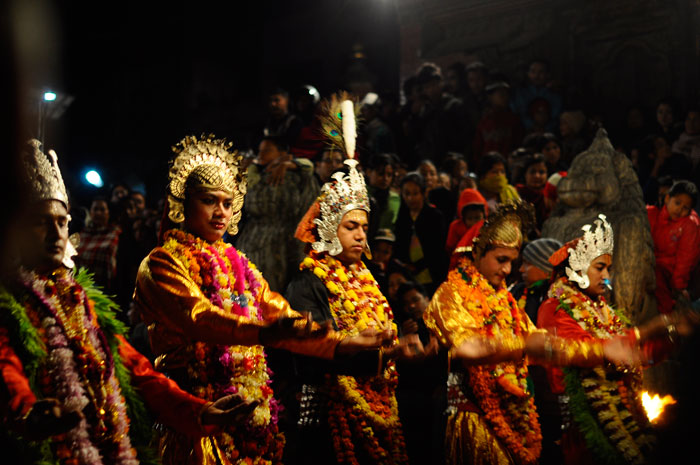
As 3rd of November 2016 draws near, the light in the first floor room of the Degu Taleju temple stays on for longer than usual. The said floor, taken up by a special committee – a society, if you will, is neatly tucked behind by a tiki-jhya, a latticed window. For the rest of the year, the lights there flicker on for few minutes here and there, but once the monsoon ebbs downand the atmosphere invokes swonti, the light of the office tends to stay on, and on. And, why wouldn’t it? The dancers and the organizers behind the KartikNachare busy at work preparing for a great show.
.jpg) KartikNach
KartikNach
Started at least three and half centuries before, KartikNachhas braved dynastic changes and survived through the numerous turbulent times throughout its history. The dance drama tradition, which is calledKartikPyakhan in Newari, was started by the devout Vishnu worshipper Siddhi NarsinghMallain the mid-16th century. It was later on expanded on by his son, Srinivas Malla and grandson, Yog Narendra Malla into a month long program, pausing in between mohniandswonti(during Dashain and Tihar) before resuming.
Myths and historical references surrounding this tradition has it that Siddhi Narsingh initiated the dance-drama as a protective measure for his kingdom and to ward off the general despair his kingdom had fallen into. It worked miraculously, as things tend to do in the mythical past, and the kingdom regained its lost lustre, bounced back and what have you. Those were indeed the simpler times – the world would have certainly drowned in such recitals if the power of the tradition held sway in these trying times.
KartikNach, when it was started, followed a long standing tradition of such dance dramas in the valley. What little evidence and dynastic chronicles we have points to the fact. There is a mention of a dance drama ‘RamakanNatika’ (Character of King Ram) well before other dance traditions started in the city. This dates back to the founding of Lalitpur as an independent city around 1423 - 1452 BS (1366 - 1395 AD).
RamakanNatika, composed by a learned man named Dharmagupta, was written largely in Sanskrit. This play was staged in a dabali(elevated platform made especially for staging dances and musical events) in Patan. This is not to say historical records don’t go back, when it does. Stone inscriptions and chronicles reporting on the Licchavi period (4th to 9th Century) highlights a widespread tradition of dance and drama supporter by the rulers. They mention Natya-gosthis while several Uma Mahesvaraicons of the same period show dancers attending the main divine couple. At a glance, it looks like the performing arts flourished under the Malla dynasty.
The Gopalrajvamsavali mentions King Anandadeva (1308 – 1320) as having commissioned a play staged weekly. In the time of King Jayasthiti Raj Malladeva (1382-1395) another, Chaturanga Ramayanwas staged. A third play mentioned, Bhairavananda, was shown in all three towns to celebrate King Dharmamalladeva’s marriage, its inaugural performance being recorded for NS 503 (1383 AD). In fact, so common was such dance-drama tradition that several scholars have reported no less than nine dance troupes which were invited from surrounding villages and from Kathmandu to perform at the Bhaktapur palace on the occasion of the bratabandha (a boy’s initiation into manhood) of the crown prince during Bhupatindra’s reign (1762-1769).
One thing that stands out from these historical references is the royal patronage of the arts. Royal palaces patronized a number of troupes which engaged in music, dance and drama, including comedy. They were occasionally invited to perform at the palace during festive celebrations of the royals. They were fed and sheltered, and sometimes generously rewarded by the palace, which brings us back to the present time.
.jpg) Then and Now
Then and Now
Remember the lights on the window on the first floor of the Degu Talegu temple in Mangal Bazaar, you know, the office of the KartikNach Preservation Committee? Of course, they are staying late as the dance approaches, but not just to prepare. In between preparing and training new crop of dancers who’ll take the dance form in the future, the organizers are busy managing the resources with which to organize. Royal patronage, which later translated into hand-outs from the GuthiSansthan, Municipality and the likes, hasn’t kept up with the times, and what paltry sum they’ve promised has slowly decreased. “It is challenging, of course,” says Uttam Ratna Shaya, treasurer of the committee. “Without the generous local benefactors, local organizations and well-wishers, it would’ve been difficult to organize this year after year.”
Despite limited resources, they are adamant to continue upholding the tradition. Starting from last year, the committee have started a fundraising drive during the recitals, and donations have slowly trickled in. This crowdsourcing attempt to fund our intangible heritage is surely one way to keep it alive in these changing times. If you’re interested, donate to the cause in this bank account: KartikNach Preservation Committee, Nepal Bank account number: 180-11-59709.
Let’s say you’ve donated, but is your duty done? No, if you donate and stay home that doesn’t mean much. Every performance arts need audience to thrive, it’s not just financial resources, you know. Support the dance form as it’s a part of our cultural identify. It isn’t every day when you can do something to help a three centuries art form thrive for years to come.










